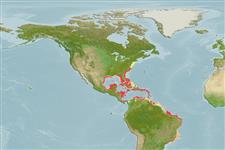Preferred temperature (Ref.
123201): 25 - 28, mean 27.2 °C (based on 158 cells).
Phylogenetic diversity index (Ref.
82804): PD
50 = 0.5000 [Uniqueness, from 0.5 = low to 2.0 = high].
Bayesian length-weight: a=0.02239 (0.01442 - 0.03475), b=3.02 (2.89 - 3.15), in cm total length, based on LWR estimates for this species & Genus-body shape (Ref.
93245).
Niveau trophique (Ref.
69278): 3.5 ±0.2 se; based on diet studies.
Résilience (Ref.
120179): Haut, temps minimum de doublement de population inférieur à 15 mois (Preliminary K or Fecundity.).
Fishing Vulnerability (Ref.
59153): Low vulnerability (10 of 100).
Nutrients (Ref.
124155): Calcium = 101 [52, 160] mg/100g; Iron = 0.827 [0.486, 1.386] mg/100g; Protein = 18.7 [17.5, 19.8] %; Omega3 = 0.13 [0.08, 0.21] g/100g; Selenium = 35.6 [19.6, 67.4] μg/100g; VitaminA = 50.6 [14.7, 171.2] μg/100g; Zinc = 1.36 [0.92, 1.97] mg/100g (wet weight);
